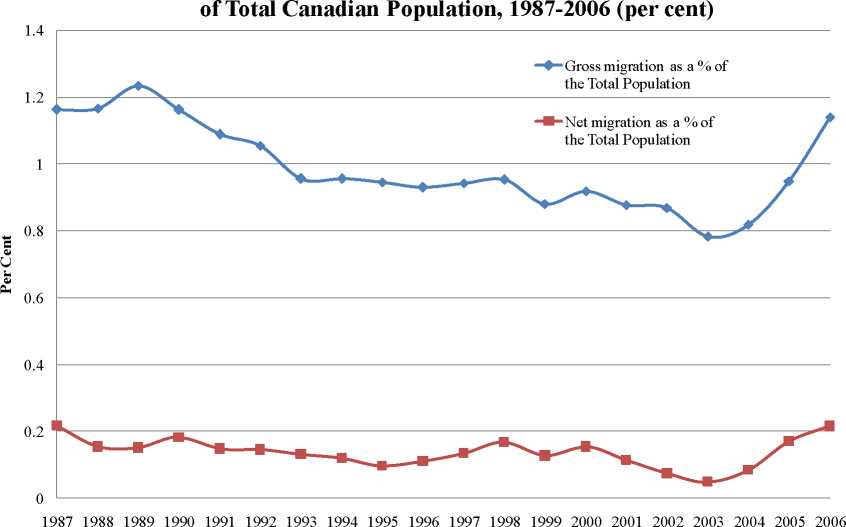39
purpose of these estimates is to show that migration does contribute to productivity
growth. The first methodology uses the impact of interprovincial migration on earnings to
estimate the gains from migration. The second methodology uses inter-provincial labour
productivity differences.
Chart 13: Total Number of Interprovincial Migrants as a Percentage

Source: Interprovincial migration from Statistics Canada CANSIM Table 051-0019. Total Canadian population
from Annual Statistics Canada Estimates, CANSIM Table 051-0045.
Persons migrate largely for economic reasons, so not surprisingly migrants
experience larger gains in earnings than non-migrants. Using the tax data from the
Longitudinal Administrative Database (LAD), Ross Finnie found that interprovincial
migrants in Canada experienced a 9.4 per cent increase in earnings over a two-year
period, compared to 4.8 per cent for stayers and 0.8 per cent for others (Finnie,
2001:Table 1a). In other words, interprovincial migrants enjoyed a 4.6 per cent wage gain
27
relative to stayers.
intraprovincial migration rate, defined as migration between census divisions (Ontario has 47) in Canada
was 2.76 per cent, more than three times the interprovincial migration rate of 0.88 per cent.
27
An earlier study by Lin (1995) on the economic returns to mobility also found that moving to another
province pays off greatly. On average, male migrants' nominal earnings from paid employment increased
by $7,682, while those of non-migrants increased by only $2,162, a net earnings return to mobility of
$5,520 or nearly 26 percent of male migrants' pre-move earnings. The earnings return to female mobility
was a bit smaller than that of males in magnitude, but even higher (nearly 45 percent) when expressed as a
percentage of female migrants' pre-move earnings.
More intriguing information
1. Economie de l’entrepreneur faits et théories (The economics of entrepreneur facts and theories)2. Gianluigi Zenti, President, Academia Barilla SpA - The Changing Consumer: Demanding but Predictable
3. Citizenship
4. On the estimation of hospital cost: the approach
5. The name is absent
6. The name is absent
7. The name is absent
8. Fortschritte bei der Exportorientierung von Dienstleistungsunternehmen
9. Wage mobility, Job mobility and Spatial mobility in the Portuguese economy
10. The name is absent